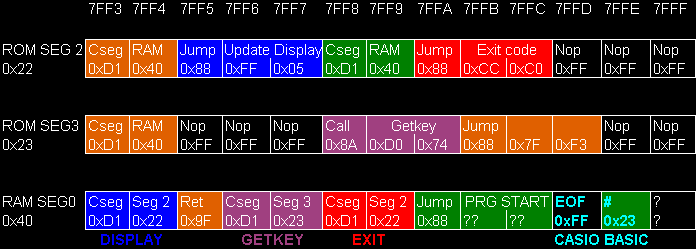
Assembler support - cfx 9850 G
This is schema of access points, whch I have created
to enable asm on cfx.

How is machine code executed:
ROM in segment 2 contains table of jums, for every possible token one address, so I changed vector for token "#" from target routine "Syn ERROR" to "PRG START" access point at ROM seg 2:7FF8 , where is changed the segment to RAM. So on the address 7FFA in RAM MUST be instruction of jump to our code. The code should end jumping to 7FF8 where MUST be instruction of change segment to 2 (D1 22) - "EXIT" access point. It points to jump to the routine, which parses comments (token "'") - this solves skipping program arguments.
To read keyboard simply call address 7FF6 where MUST be "GETKEY" access point (instruction of change segment to 3 (D1 23)).
To update display after VIDEO RAM change simply call address 7FF3 where MUST be "DISPLAY" access point (instruction of change segment to 2 (D1 22)).
Return from these routines is done by changing segment to RAM at the address 7FF5, so there MUST be return part for "RET" access point (instruction for return (9F)).
Table of program interface - previous picture as a table
| ROM Seg2 | ROM Seg3 | RAM | |
| 7FF3 | D1 Cseg | D1 Cseg | D1 Cseg |
| 7FF4 | 40 RAM | 40 RAM | 22 ROM Seg2 |
| 7FF5 | 88 Jump | FF Nop | 9F Ret |
| 7FF6 | FF <Update disp> | FF Nop | D1 Cseg |
| 7FF7 | 05 <Update disp> | FF Nop | 23 ROM Seg3 |
| 7FF8 | D1 Cseg | 8A Call | D1 Cseg - Jump here to exit your code |
| 7FF9 | 40 RAM | D0 <Getkey> | 22 ROM Seg2 |
| 7FFA | 88 Jump | 74 <Getkey> | 88 Jump |
| 7FFB | CC <Exit code> | 88 Jump | <Hi addr of your code starts> |
| 7FFC | C0 <Exit code> | 7F | <Lo addr of your code starts> |
| 7FFD | FF Nop | F3 | FF (Casio Basic - EOF) |
| 7FFE | FF Nop | FF Nop | '#' (call routine in RAM - executing the file causes running this file as a machine code) |
| 7FFF | FF Nop | FF Nop | ?? - This byte is accessible only via backup send/receive |
If you do not want to make your binaries yourself, you can use my compiler (assembler).
Unknown opcodes ? Read this.